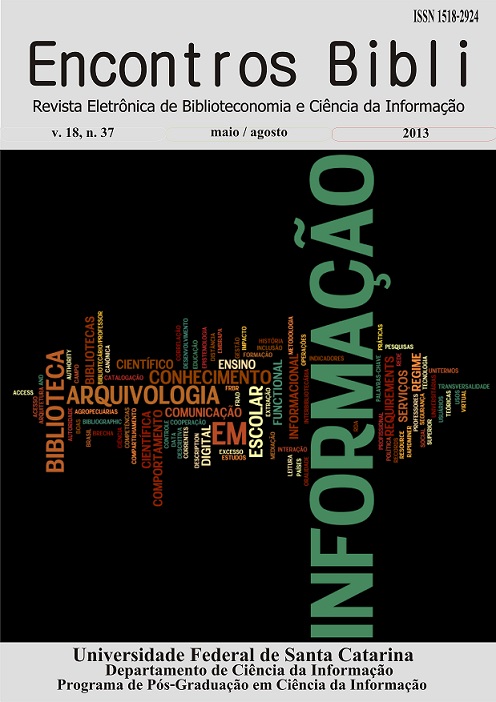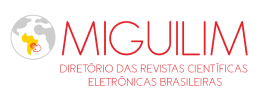Creating and visualization from a thesaurus of technical vocabulary ofinformation and communication
DOI:
https://doi.org/10.5007/1518-2924.2013v18n37p303Keywords:
Knowledge Visualization, Thesaurus, ICT, Networks Analysis Support, Controlled Vocabulary and Mixed MethodsAbstract
In this paper makes an exploratory research from the creation of athesaurus and then propose a visualization of the French terminology ofinformation technology and communication (ICT). Our corpus is constitutedfrom the "Dictionary of information technology and communication",published in 2009 by the General Commission on Terminology and neologismsof France, who compiled the words, phrases and definitions published in theOfficial Journal. The first visualization display 670 terms in which theinformation is represented by nodes and links between these nodes labeledto show the semantic relationships. The thesaurus we have built usingspecific software (TemaTres). The second visualization was made fromtextual ART network analysis allowed us to encode relations between termsand building a network. Finally, it was a representation of the structureSKOS thesauri. For this we use the methods and tools of social networkanalysis (ARS) applied to text data, taking into account a concept as anabstraction of reality and therefore a reflection of anthropologicalthought. This multifaceted view revealed through mixed methods, we can seewhat is here representing ICT and its evolution over time, and finallydiscuss the advisability of current practice.
Downloads
References
Aitchison J., Gilchrist A.(1992). Construire un thésaurus – Manuel pratique, ADBS Éditions, 1992, 222p.
Bagola, B. (2004). L'américanisation de la langue française sur Internet ? Quelques aspects de la terminologie et de l’usage des internautes, in: Globe, Revue internationale d’études québécoises 7: 2, p.101-124.
Burkhard, R.A. (2005), Towards a Framework and a Model for Knowledge Visualization: Synergies Between Information and Knowledge Visualization, Knowledge and information visualization : searching for synergies, 3426, p.238-255.
Commission générale de terminologie et de néologie. (2009). Vocabulaire des techniques de l’information et de la communication(TIC)l. Termes, expressions et définitions publiés au Journal officiel 2009. Tiré de : http://www.culture.gouv.fr/culture/dglf/publications/ vocabulaires/Vocabulaire_TIC_09.pdf
Diego Ferreyra, (2013). Tematres (Version 1.6.3) [Logiciel]. Tiré de http://www.vocabularyserver.com/
Cardon D.(2012). « Regarder les données », Multitudes, n° 49, p. 138-142. DOI : 10.3917/mult.049.0138
Degenne A., Forsé M.(1994). Les réseaux sociaux, Paris, Armand Colin
Desmet, I. (2006). « Néologie de spécialité et néologie banalisée en Informatique et TIC: de la recherche aux dictionnaires de langue générale », in La langue française dans l'aventure informatique, colloques LEXIPRAXI 2005-2006, Paris, AILF.
Eades P. (1992)."Drawing Free Trees", Bulletin of the Institute of Combinatorics and its Applications, p. 10-36.
Engelhard, P. (2012). Internet change-t-il vraiment nos sociétés? L'Internet et ses problèmes. L'Harmattan.
Gonzalez, Ramirez & Ferreyra. (2011). “TemaTres: software to implement thesauri”, in Profesional De La Informacion Volume: 21: 319-325.
Larson A., Starr J.A.(1993). “A network model of organization formation”, Entrepreneurship Theory and Practice, 17(2): 5–15.
Maniez.J,( 1976). « Terminologie et thésaurus: divergences et convergences », Terminologies 76: Colloque international, Paris-La Défense, 15-18 Juin, p. IV39-IV50, La Maison du dictionnaire, Paris.
Reingold E.M., Tilford J.S .(1981). “Tidier drawings of trees”, IEEE Transactions on Software Engineering, 7(2):223-228.
Smith, M., Milic-Frayling, N., Shneiderman, B., Mendes Rodrigues, E., Leskovec, J., Dunne, C., (2013). NodeXl (version 1.0.1.245 ) [Logiciel]. Tiré de http://nodexl.codeplex.com/
Teun A. Van Dijk,. (2013). Texte, Contexte et Connaissance, Semen [En ligne], 27 | 2009, mis en ligne le 10 décembre 2010, consulté le 10 juillet 2013. URL : http://semen.revues.org/8901
H. Hansen, Derek L., Ben Shneiderman, and Marc A. Smith. (2011). Analysing Social Media Networks with NodeXL: Insights from a Connected World, Morgan Kaufmann, 284 pp. p. 96-102
Viaud Marie-Luceet & al.(2006). «Cartographies interactives» Graphes, diagrammes et arborescences pour l'accès aux vidéothèques numériques, Document numérique, Vol. 9, p. 57-81.
Walker J. Q.(1990). "A node-positioning algorithm for general trees", Software, Practice and Experience, 20(7), p. 685-705.
Downloads
Published
How to Cite
Issue
Section
License
Copyright (c) 2013 Audilio Gonzales Aguilar

This work is licensed under a Creative Commons Attribution 4.0 International License.
The author must guarantee that:
- there is full consensus among all the coauthors in approving the final version of the document and its submission for publication.
- the work is original, and when the work and/or words from other people were used, they were properly acknowledged.
Plagiarism in all of its forms constitutes an unethical publication behavior and is unacceptable. Encontros Bibli has the right to use software or any other method of plagiarism detection.
All manuscripts submitted to Encontros Bibli go through plagiarism and self-plagiarism identification. Plagiarism identified during the evaluation process will result in the filing of the submission. In case plagiarism is identified in a manuscript published in the journal, the Editor-in-Chief will conduct a preliminary investigation and, if necessary, will make a retraction.
This journal, following the recommendations of the Open Source movement, provides full open access to its content. By doing this, the authors keep all of their rights allowing Encontros Bibli to publish and make its articles available to the whole community.
Encontros Bibli content is licensed under a Creative Commons Attribution 4.0 International License.
Any user has the right to:
- Share - copy, download, print or redistribute the material in any medium or format.
- Adapt - remix, transform and build upon the material for any purpose, even commercially.
According to the following terms:
- Attribution - You must give appropriate credit, provide a link to the license, and indicate if changes were made. You may do so in any reasonable manner, but not in any way that suggests the licensor endorses you or your use.
- No additional restrictions - You may not apply legal terms or technological measures that legally restrict others from doing anything that the license permits.

























